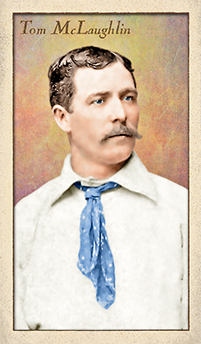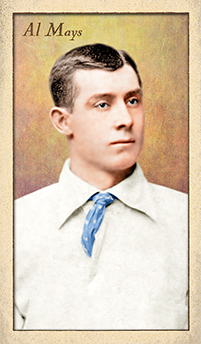
- Series: Jim Dandie Feds
- City: Pittsburgh
- Team: Rebels
- League: Federal League
Michael William Menosky (1894-1983) earned the nickname “Leaping Mike” for his abilities in the outfield and had some fine years at the plate, particularly for the Red Sox, in his nine-year tenure in the majors. He got his chance with the Pittsburgh Rebels of the Federal League in 1914. The team was aptly named, being one of the “outlaw” clubs that vied with the two established circuits for two years. The Rebels had come into the league as the Stogies, the old Union Association team in the Steel City. In its 1912 incarnation, the club was known as the Filipinos, reflecting not a heretofore unknown Asian connection to baseball, but in honor of its manager Deacon Phillippe. Ah, the romance of the early game! Menosky put up very average numbers in Pittsburgh and then with the Senators, a stint interrupted in 1918 by the war in Europe. He came into his own with Boston where he finished his career from 1920-23. His first three years in Fenway saw Mike bat .297/.300/.283 playing as a regular. His final campaign saw a marked drop-off in offense as he slumped to .229 in only 84 games. These seasons in Beantown pumped up his lifetime batting average to a solid .278. Menosky had speed, witnessed by his 10 triples and 22 steals for Washington in 1917 and the 23 stolen bases for Boston in 1920 that ranked fourth in the AL. He was the Sox' regular left fielder his first two seasons and opened in center in 1922, but only played four games there. Boston released the veteran after the '23 season and Mike went west to play for the PCL's Vernon (southeast Los Angeles) team.
- Menosky became a probation officer after leaving baseball. He played an interesting “expert witness” role in a criminal case involving a defendant charged with hurling a rock through a Detroit railroad terminal window. When the judge was skeptical that the man had the arm for that misdeed, he called Mike to demonstrate what a major league outfielder could do. When Menosky failed to throw the missile the 250 feet required to reach the window, the judge dismissed the case, reasoning that if Mike couldn't do it, the poor suspect couldn't have either

- Series: Diamond Heads '15
- City: St. Louis
- Team: Terriers
- League: American League, Federal League
- Hall: Cuban Baseball Hall of Fame
Armando Marsans (1887-1960) was the first Cuban to make a real impact in the major leagues. Frank Bancroft had spotted Marsans and Rafael Almeida in exhibition games in 1905 and finally brought them to Cincinnati in 1911. In his sophomore season with the Reds, Marsans hit .318 with 35 stolen bases and only 17 strikeouts in 448 plate appearances, placing a respectable 18th in Chalmer’s Award voting for 1912. A row with fiery manager Buck Herzog resulted in Marsans seeking a job with the new Federal League’s St. Louis Terriers in ‘14. When the league folded, Marsans signed on with the Browns but inactivity took a toll. Two years with the Yankees ended his MLB career in 1918 but Armando had many more years of baseball left. He continued to play winter ball back home through the 1928 season and became the first to play in the majors and the Negro Leagues in 1923 with the Cuban Stars. Marsans thrived as a manager in both Cuba and the States (another first for his countrymen), finally retiring in 1947 after 43 years in baseball.
- The blue-blood Marsans was well-educated and an entrepreneur as well as a savvy baseball mind. Nevertheless, the Reds fended off race-baiting accusations in 1911
- Artist’s Note: Images of Marsans are fairly rare and it is not uncommon for me to take liberties with dates and uniforms. This photo was taken in 1916 when Marsans was with the St. Louis Browns. In anticipation of the feedback I will receive, I’d like to invite you to join me in pretending this is a St. Louis Terriers’ uniform. Cheers!
- Elected to Cuban Baseball Hall of Fame in its inaugural class: 1939

- Series: 1880s: Spotted Ties
- City: New York
- Team: Metropolitans
- League: American Association
Thomas McLaughlin (1860-1921) was primarily a shortstop for three American Association franchises beginning with the Louisville Eclipse in 1883 and finishing up with the Washington Statesmen in 1891 following a four-year hiatus from the big leagues. Never much of a hitter, Tom's career lasted as long as it did on the merits of his defensive skills. His swan song with D.C. was his best at the plate where he hit .268 - but in only 50 plate appearances.
McLaughlin's career average was a lowly .192, but his nadir came with the Metropolitans in 1886 when he hit .136 with an OPS+ of 22 (league average is 100). The underwhelming performance pushed McLaughlin back to the minors for four years. He had played much more previously for Louisville and, in his final year with what was by then the Colonels, was in every one of that 112-game campaign of 1885.
McLaughlin's '86 sojourn with the Mets earned him a place in Old Judge's “spotted tie” series that we feature here. All of which proves that lasting fame is not always the result of on-field prowess, but can also be a function of being at the right place at the right time. The same could be said of the entire Metropolitan squad of 1886, which featured ace Jack Lynch going 20-30 while the team's record was 53-82 en route to a 7th place finish where the Mets trailed 38 games behind the dominant St. Louis Browns.
- Tom's exile to the minors saw him travel from New Jersey (Newark of the International League) to Toronto, St. Paul and, finally, Syracuse to open the '91 season before his call-up to Washington.
- His personal-best hitting came with the Stars: .280, which led to his final attempt to hit big league pitching
Auction History
Cartophilia
Old Judge Pose: 316-1

- Series: 1880s: Spotted Ties
- City: New York
- Team: Metropolitans
- League: American Association
Albert C. Mays (1865-1905) began in professional ball as a pitcher with Oil City of the Iron and Steel Association in 1884. He signed the next season with Louisville of the American Association. As the third-string hurler, Mays went 6-11 for the Colonels. He had a decent ERA of 2.76 for a sixth-place team that struggled to score runs. Mays moved to New York and the Metropolitans in '86 but continued to lose many more than he won. It was so bad in '88 that the woeful Mets (not the last time the Big Apple would bind those two words) were 44-89 with Mays providing 17 of the wins and 34 of the losses. He hurled 441 innings with a 4.73 ERA. Al's 34 defeats were the league record that year as were the 232 earned runs allowed. Thereafter, staying exclusively in the AA, Mays played for the Brooklyn Bridegrooms late in 1888 where he got to contribute to a second-place finish with a 9-9 record. He finished up with the Columbus Solons where he clearly enjoyed better run-support as he was 10-7 in 1889 with a 4.82 ERA before ending his MLB tenure the following season with but one decision, a complete-game loss.
- Mays was the only native of little Dover, Ohio to play in the big leagues. Sadly, his life ended tragically in a drowning accident at age 39 in Parkersburg, West Virginia
Auction History
Cartophilia
Old Judge Pose: 299-1

- Series: Beginnings: 1880's
- City: Indianapolis
- Team: Hoosiers (NL)
- League: National League
- Hall: National Baseball Hall of Fame
An error or a practical joke? The Old Judge series is littered with errors, primarily in the form of misspelled names. There are also a number of cards that are intentionally humorous. The McGreachery card is likely a display of the sense of humor within Goodwin’s art department rather than a mistake.
During this card’s production run from 1887 to 1890, James Laurie White was the oldest player in the major leagues all four years, spanning his age 39 to age 42 campaigns. By that point, White was a baseball veteran of 20 seasons whose tenure predated the National league by five years and ended with the birth of the Player’s League in 1890. By all accounts, White was a serious, religious and principled man who earned the nickname Deacon. White didn’t drink, smoke or gamble and was as knowledgeable and articulate about farming as he was about baseball. Henry Chadwick wrote that White’s character was beyond reproach. Combine White’s character, values, baseball moxie, and his old world perspective - which purportedly included a belief that the Earth is flat - and you can see why the folks at Old Judge might poke fun.
- Excluding the Ars Longa 1880s Diamond Duos & Spotted Ties subsets, Deacon White will be the only player represented in the 1880s base set twice, although his name will still only appear on one card. I just couldn’t resist paying a little tribute to the humor in the Old Judge series by creating a card for the dear old crank McGreachery.
- Why the Old Judge folks assigned the fictitious McGreachery as a manager may be obvious. Why they assigned him to Indianapolis is a mystery and perhaps an inside joke that has long since lost its insiders.
- Watch Burnham is a man who appears in the Old Judge series who actually did manage the Indianapolis Hoosiers - for all of 28 games (losing 22 of them). Perhaps the absence of an enduring Indianapolis manager in the Old Judge series prompted McGreachery's assignment there.
- Only two examples of the original Old Judge card are known to exist




